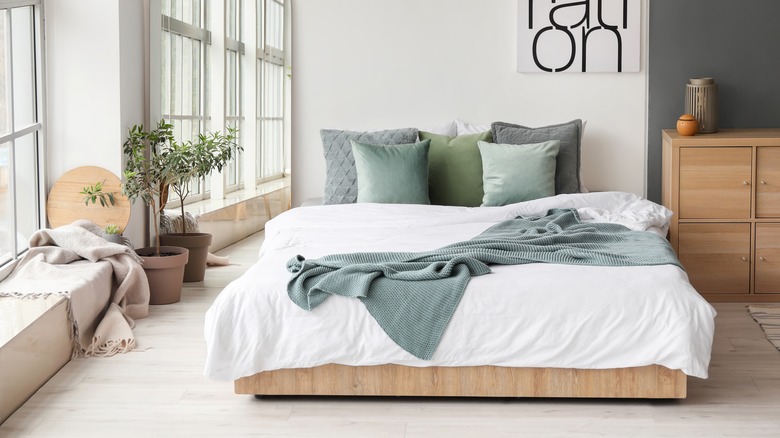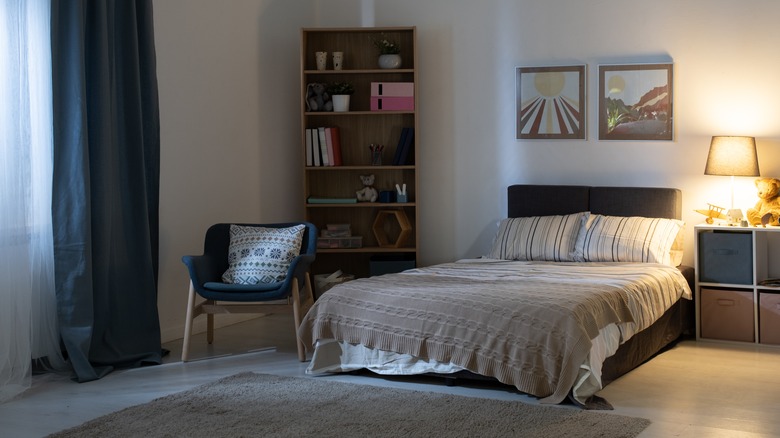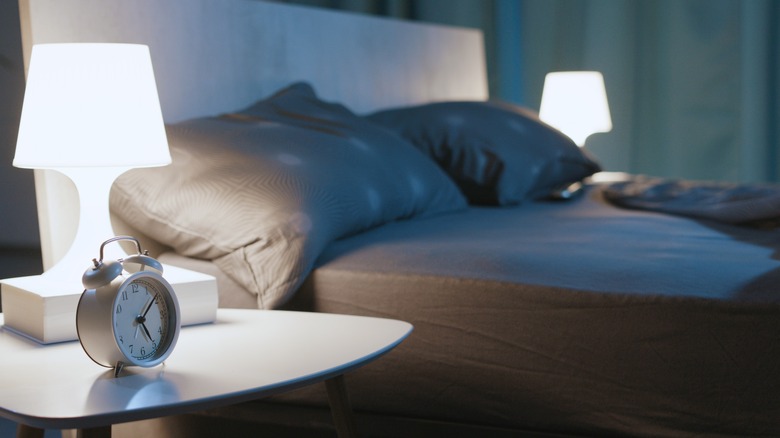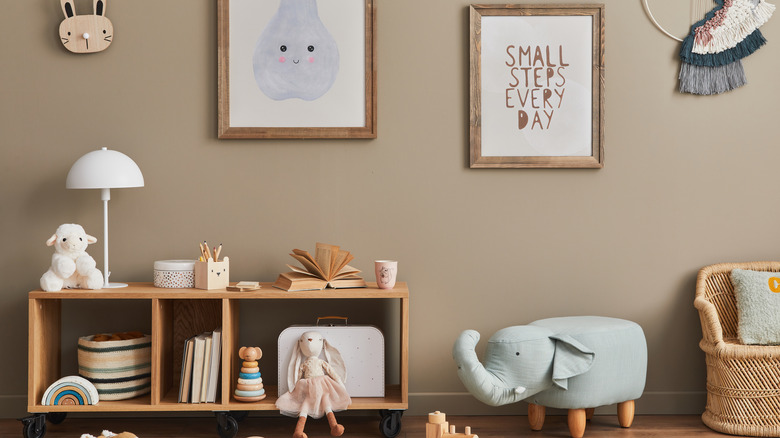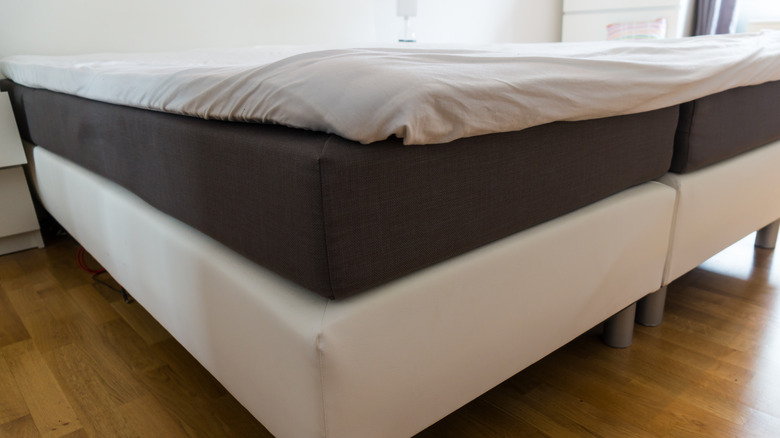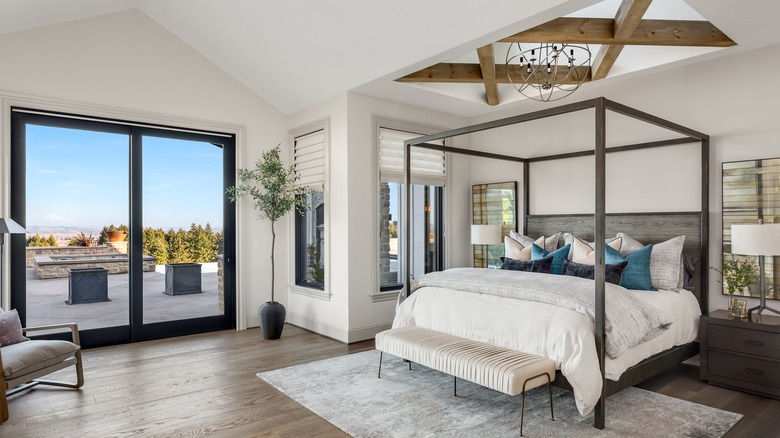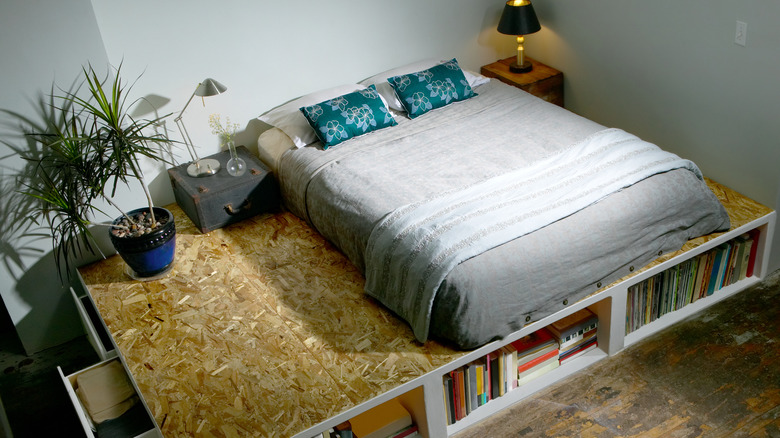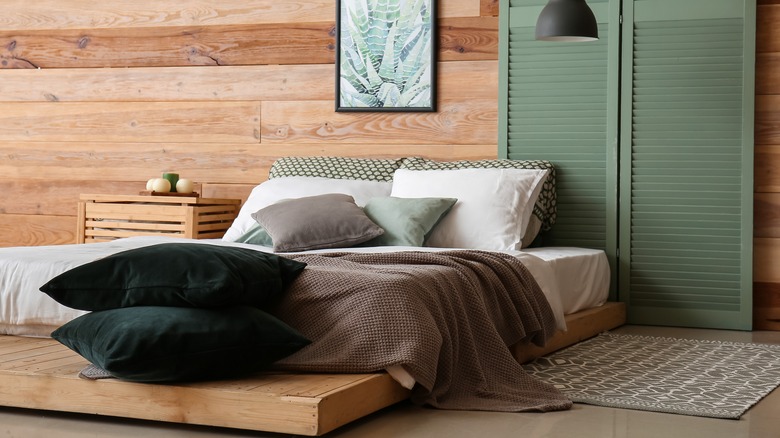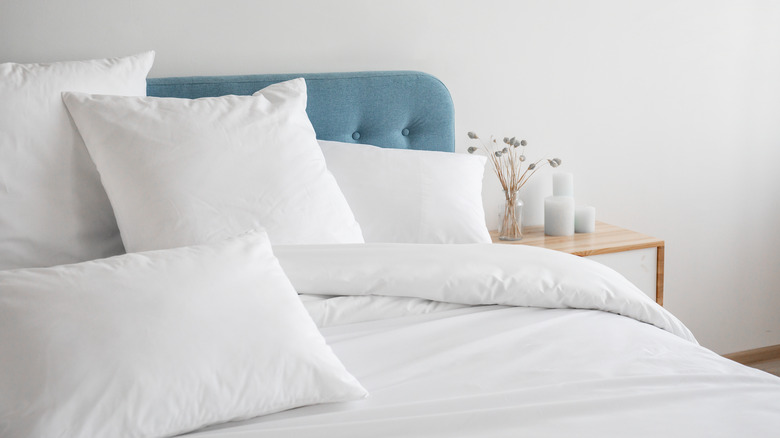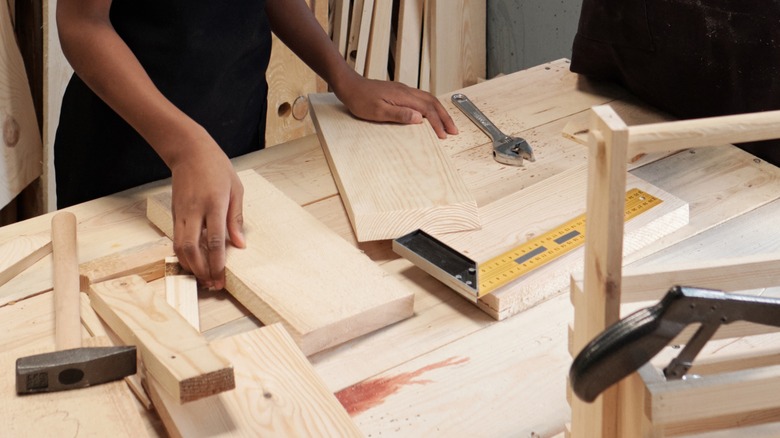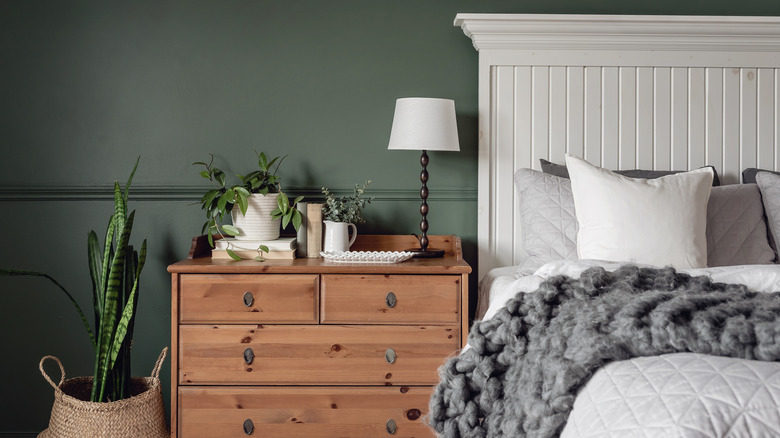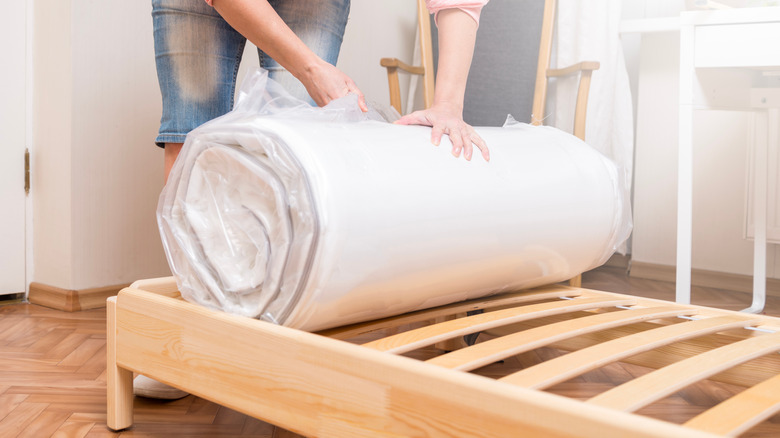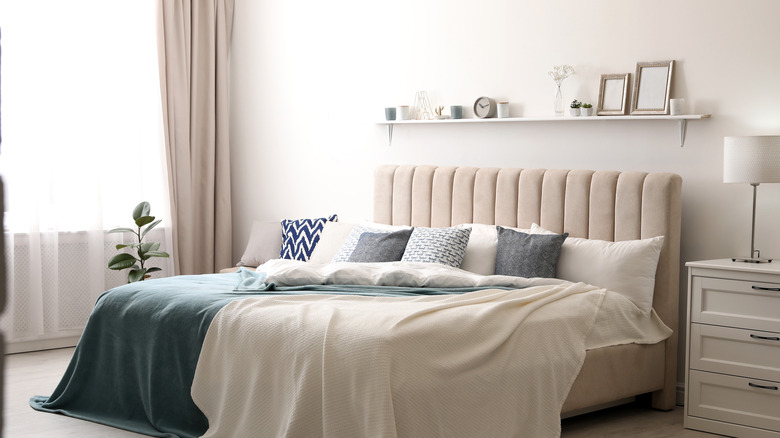Platform Bed Vs. Panel Bed: What's The Difference?
Furnishing a bedroom can be both exciting and overwhelming. When shopping for a bed frame, there are so many different factors to consider. The size of the bed, its specific features, the materials used, and the type of mattress you'll need are all things that go into the decision. According to Casper, important things to consider when purchasing a new bed frame are the size of the space and your mattress, the room aesthetic you're going for, and your budget. It's important to consider factors like room size because a bulky bed frame can make a space appear cluttered, while a taller frame can add elegance to your space without being overly dominant (via Wayfair).
While a bed frame may feel like a small detail, according to Adorable Home, it's one of the most significant things you can add to your space, because a bed is usually one of the main focal points in a bedroom. The type of bed frame that you purchase can help define the style of your room. The two most popular bed styles are platform beds and panel beds — let's compare the two.
What is a platform bed?
A platform bed is one of the most recognizable beds in interior design. According to eachnight, platform beds are specifically designed to support a mattress without a box spring. As their supportive structure, platform beds most commonly use wood slats that are spaced around 2 inches apart. This style of bed is a favorite of many because it allows for a lot of customization. Often, the beds come with built-in storage under the platform that holds the mattress, which is great for those who live in small homes or apartments (via Houzz).
Platform beds also give homeowners an option to design their room as they see fit, as they can have a low-profile, be raised, and they also have different headboard and frame options. As you can probably tell, platform beds come in a variety of styles. From super modern and minimal to upholstered and tufted, ones with spanning headboards to no headboard at all, there is something that can fit any style and room requirements out there (via HGTV).
What is a panel bed?
A panel bed (sometimes referred to as an open space bed) is another type of bed that's very common. According to DreamCloud, these beds are known for their very traditional appearance — sometimes called traditional bed frames — that are synonymous with early 20th century interior design. At this time, mattresses were being mass produced, and therefore so were panel beds. Specifically, beds from this era have ornate detailing along the bed frame.
Panel beds are also known for their raised headboards, side panels, and sturdy base. Some have footboards, too. Nowadays, these beds have been modernized and can be made with slats, similar to a platform bed. They can also be made of materials ranging from solid wood to wicker, and incorporate metal rods or added upholstery. The most differentiating feature between a platform and panel bed is that a panel bed typically requires a box spring — something that we'll discuss in more detail later.
Is the bed going in a child's room?
One of the first factors you should consider when purchasing a new bed frame is who will be sleeping in the bed. While all beds seem interchangeable, that isn't always the case, as what's best for a child's room is often different than for a master suite. According to The Kuotes, when purchasing a bed for an adult, it's important to consider that the height of a standard mattress is usually around 9 inches, and if you need a box spring, that will add an additional 5 to 6 inches — that may be quite high for a child. While children's beds usually are platform and do not use box springs, headboards and side rails are sometimes factors as well.
Additionally, Designer Daniella Hoffer tells Cubby, "Look for a strong, durable frame that can hold up to kids having pillow fights and just being kids." Sturdier bed frames tend to be made of solid wood or metal. Platform beds are typically picked for children because of their potential for additional storage space and the wide variety of material options (via Rize). Platform beds are also one of the more portable bed frames, making them an investment that can grow with the child, especially as they redecorate and rearrange their space.
Do they need box springs?
Another factor when picking a bed frame is whether or not it requires a box spring. According to Sleep Advisor, a box spring is a foundation that lifts your mattress — but not all mattresses need one. And, as we've learned, not all bed frames require a box spring either. For example, any bed frames that have slats, like a platform bed frame, do not need one. Additionally, if your panel bed has equally parted slats, you may be able to get away without using one too.
Mattresses that are made of memory foam, including full memory foam or hybrids with foam and coils, do not require a box spring. Since their weight can damage a box spring, latex mattresses should not be paired with one either. Yet, innerspring mattresses work best with box springs, because they provide additional support to the sleeper.
Box springs are sometimes preferred because they elevate a bed, making it visually pleasing, and they also help absorb shock, preventing you from tossing and turning when you sleep. However, it's important to note that bed frames that use box springs have reduced storage space under their beds. So, box springs are not the best choice for children's bedrooms or for homeowners that need additional storage.
Consider the types of bed bases
As you research bed frames, you'll notice how similar they all are. In the past, certain types of beds had very unique attributes that distinguished them and allowed us to easily know what type of bed frame they were. Nowadays, because of advances in design and sleep technology, the areas are blurred and types of bed frames have become more about interior design aesthetics than functionality. In fact, many bed frames are no longer called by their names, instead they're distinguished by the type of base they use.
According to Casper, platform beds are known for three distinct bases: solid, slatted, and metal. While panel beds are known for having an open frame, or lack of foundation, such as the Ashley Bed from Hillsdale Furniture. However, panel beds can also have supportive slats installed, as seen with the Catawba Hills Poster Bed from Liberty Furniture. There are also panel beds, like the Nativa Interiors Aylet Vertical Channel Tufted Bed, that have supportive slats but are made specifically for box spring mattresses.
Slatted bases use slats to add additional support and ventilation to the mattress, while plywood bases are made of solid wood and are very supportive to the mattress. These different foundations allow for customization of your bed frame, but it's important to check the description of bed frame to determine if the bed requires a box spring or a special mattress. As you can see, it's not always a black and white situation when it comes to bed types.
Platform bed pros
According to Zoma, platform beds are so popular because they offer support and ventilation to sleepers. They are also a stylistic favorite because they are low to the ground and smaller in scale. Platform beds are perfect for apartments and small spaces because of their compact nature and the fact that they can be moved around. These bed frames are also lower in cost because they do not require special mattresses, box springs, or foundational support of any kind (via Designing Idea).
Platform beds come in a variety of design styles and can include anything from minimalistic and modern looks to iron daybeds. They are also sturdy, making them perfect for children. Additionally, slatted platform beds allow for an increased air circulation to the mattress, which prevents heat from building up and lends to cooler sleeping conditions. Platform beds are also incredibly customizable, from under-the-bed storage to headboard options. While headboards are usually built into traditional style bed frames, platforms usually let owners swap them out or go without if they like.
Platform bed cons
While platform beds are a favorite, they are not always the best option for everyone. According to Mattressnut, platform beds are not well suited for people who have mobility issues, because they are usually lower in height. The slats are also prone to breaking and occasionally will need to be replaced. Platform beds are typically 18 inches off the ground, while it's said that the ideal bed height is around 25 inches (via Sleeping Ocean).
Additionally, if you want to purchase a platform bed, but need extra storage, make sure to pay careful attention to the height of the bed (via myAyan). While some platform beds can be perfect for storage, they must be high enough off the ground, so that's something to be aware of. Lastly, some people may also not like platform beds simply because they do not match their aesthetic, as they are typically simple and minimalistic in design.
Pros and cons of panel beds
Beds that require box springs do not always get the most praise, but those who do love them swear by how great they are. According to MasterClass, a benefit of box springs is that they add extra height, which is great for those who need more support in getting in and out of bed. Box springs also give your bed even support, which can improve your overall sleep quality and even your posture. The additional support also helps reduce the amount of wear and tear you mattress encounters, preventing your mattress from sagging. To improve air circulation and fight against mildew and dust mites, box springs are the way to go. They come in different sizes, including low profile, which is great for those wanting a bit more of a modern look and feel (via Sleepopolis).
In terms of cons, beds that rely on box springs do not have many — except that they are an additional cost. Many people do not like the idea of spending more money, especially on top of the cost of a mattress and bed. Prices vary, stating at $100 and rising upwards of $500 (via eachnight). Additionally, box springs do not last forever. The standard box spring will last around 10 years before it needs to be replaced, but experts suggest updating your box spring every time you get a new mattress (via Sleep Foundation).
How to build a platform bed
Platform beds are a favorite for bed frame DIYs because they are so easy to build. According to Charleston Crafted, a platform bed can be built for as little as $50. When building a platform bed, you can choose how high you want it to be and how separated you want your slats to be, although 2 inches apart is the standard recommendation. Building a platform bed starts with constructing a simple platform frame, and from there you can customize the bed as needed. When building a platform bed, you can also use a method that does not rely on pocket holes. Instead, use brad nails or self tapping wood screws, making it perfect for DIYers with a limited workshop space or who don't have access to advanced tools. (via Ana White).
You can also choose to build a mid-century Japanese-inspired platform bed using a standard platform bed frame and 4x4 supports (via YouTube). Platform beds also allow you to DIY a headboard to match your aesthetic, because the foundational base is so simple and easy to build. With a few pieces of poplar and standard wood shop equipment, you're able to build a basic panel headboard (via Plank & Pillow). You can also use a few sheets of plywood and curtain panels to create an upholstered wingback headboard for a contemporary modern vibe (via Angela Rose Home).
How to decorate around a panel bed
One of the drawbacks of a panel bed is how bulky they tend to be. These beds are inspired by traditional 20th century beds and usually larger than the standard platform bed. According to Fancy Pants Home, to decorate around a large bed, center your bed in the middle of the room. By doing this, you are making your bed the focal point of the room. When you decorate around the focal point, it's easier to create a seamless look. Additionally, placing the bed in the center of the room prevents the room from looking cluttered and tricks the eye into thinking the room is bigger than it actually is.
Painting a room a lighter color and using mirrors will make the room seem larger. You can also raise curtains as tall as possible to make your ceilings appear taller and your room feel more grand. Lighting is important to brighten everything up, and this can be done with adequate accent lighting and an overhead fan or chandelier light. Decorating with glass accents makes a room appear larger and more visually appealing because light is reflected through it.
How to decorate around a platform bed
Decorating in a room with a platform bed is fairly easy because the beds are typically minimalistic and small framed. The bed does not need to be the focal point of the room unless you want to make it one. According to Wilbur Davis Studios, an ultra-low platform bed allows for a room to feel grounded. When decorating an ultra-low platform bed, work in organic elements like linen textures, plants, and soft lighting. If you don't want to make the room look organic, you can also take advantage of the additional space and create a modern look with sleek nightstands and unique lighting. Additionally, low platform beds allow for artwork to be displayed above the bed. When pairing a platform bed with artwork, look for art that will draw attention away from the bed and balance out the low height.
Platform beds also do not require headboards, allowing you to get creative around how you set up your bed. Instead of a traditional headboard, you can use a mirror to bring light and space into a small room (via Naomi Home). You can also create a photo gallery wall or display a tapestry or curtain. Statement-making wallpaper is another fun option.
Bed material considerations
These days, bed frames are made with practically anything. You can get both platform beds and panel beds made with wood, metal, wicker, upholstery, and much more. According to Linx Beds, the best bed frame material for you can vary based on your needs.
Upholstered beds are common because they are soft and visually appealing. When picking an upholstered bed, it's important to find a fabric that suits your aesthetic and lifestyle. Upholstered beds can attract dust and pet hair, so that's something to keep in mind. You can also get a wooden bed frame, which is pretty standard. These bed frames are durable, offer a natural aesthetic, and are moisture-resistant. The downside to these bed frames is that they can develop cracks and are often the most heavy option. Additionally, you can choose to have a metal bed frame, which is strong but still offers an elegant look. They are also easy to clean. When picking a material, Alluring House notes that wood and metal frames are the most durable, and that platform beds as a whole, regardless of their material, seem to be the most long-lasting frame style.
